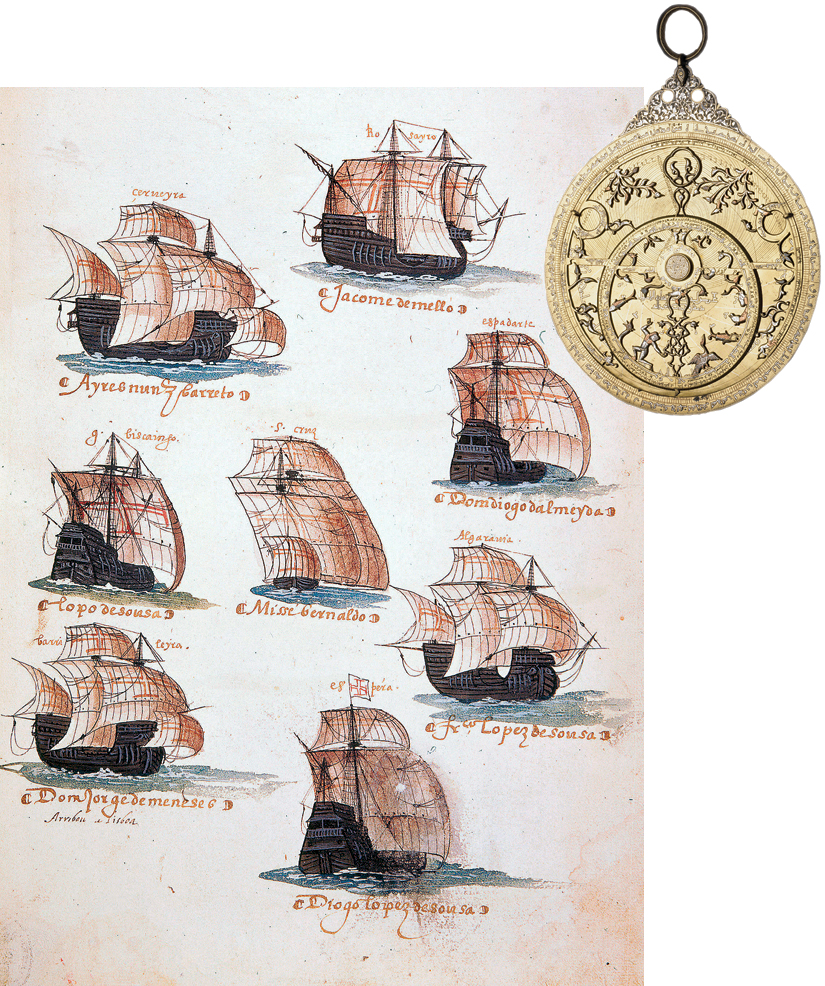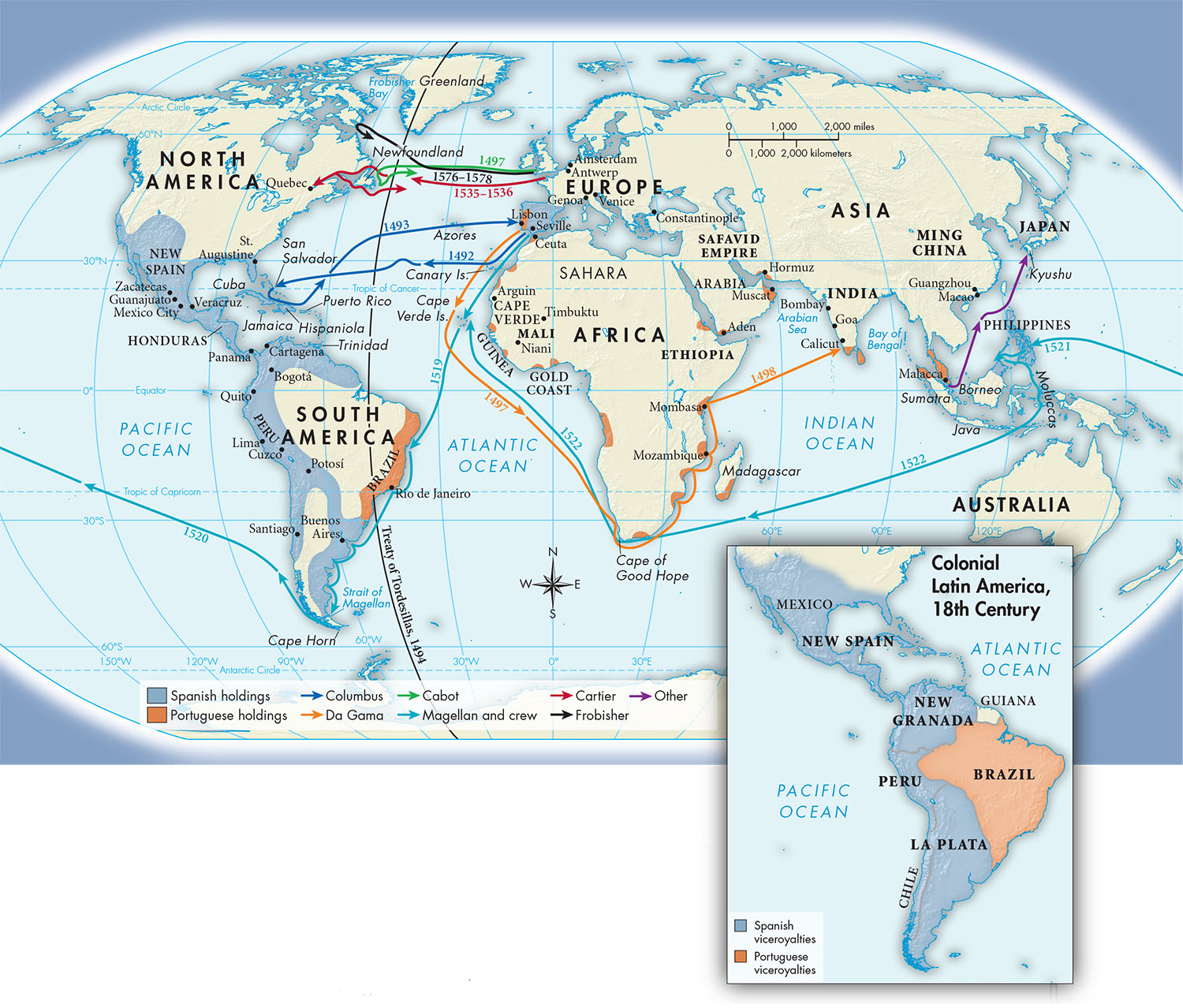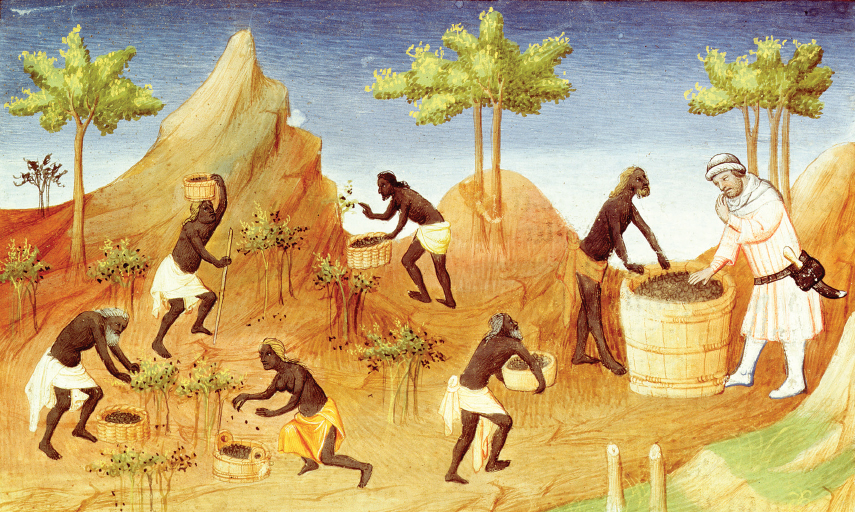A History of World Societies:
Printed Page 464
A History of World Societies Value
Edition: Printed Page 465
Chapter Chronology
The Portuguese in Africa and Asia
For centuries Portugal was a small and poor nation on the margins of European life whose principal activities were fishing and subsistence farming. It would have been hard for a medieval European to predict Portugal's phenomenal success overseas after 1450. Yet Portugal had a long history of seafaring and navigation. Blocked from access to western Europe by Spain, the Portuguese turned to the Atlantic, whose waters they knew better than did other Europeans. Nature favored the Portuguese: winds blowing along their coast offered passage to Africa, its Atlantic islands, and, ultimately, Brazil. Once they had mastered the secret to sailing against the wind to return to Europe (by sailing farther west to catch winds from the southwest), they were ideally poised to lead Atlantic exploration.

The Portuguese Fleet Embarked for the Indies This image shows a Portuguese trading fleet in the late fifteenth century bound for the riches of the Indies. Between 1500 and 1635 over nine hundred ships sailed from Portugal to ports on the Indian Ocean in annual fleets composed of five to ten ships. Portuguese sailors used astrolabes, such as the one pictured here, to accurately plot their position. (fleet: British Museum/HarperCollins Publishers/The Art Archive at Art Resource, NY; astrolabe: (c) The Trustees of the British Museum/Art Resource, NY)
In the early phases of Portuguese exploration, Prince Henry (1394–1460), a dynamic younger son of the king, played a leading role. A nineteenth-century scholar dubbed Henry “the Navigator” because of his support for the study of geography and navigation and for the annual expeditions he sponsored down the western coast of Africa. Although he never personally participated in voyages of exploration, Henry's involvement ensured that Portugal did not abandon the effort despite early disappointments.
Portugal's conquest of Ceuta, an Arab city in northern Morocco, in 1415 marked the beginning of European overseas expansion. In the 1420s, under Henry's direction, the Portuguese began to settle the Atlantic islands of Madeira (ca. 1420) and the Azores (1427). In 1443 they founded their first African commercial settlement at Arguin in North Africa. By the time of Henry's death in 1460, his support for exploration was vindicated — in Portuguese eyes — by thriving sugar plantations on the Atlantic islands, the first arrival of enslaved Africans in Portugal (see “Sugar and Early Transatlantic Slavery”), and new access to African gold.
The Portuguese next established fortified trading posts, called factories, on the gold-rich Guinea coast and penetrated into the African continent all the way to Timbuktu (Map 16.2). By 1500 Portugal controlled the flow of African gold to Europe. In contrast to the Spanish conquest of the Americas (see “Spanish Conquest of the Aztec and Inca Empires”), the Portuguese did not establish large settlements in West Africa or seek to control the political or cultural lives of those with whom they traded. Instead they sought easier and faster profits by inserting themselves into pre-existing trading systems. For the first century of their relations, African rulers were equal partners with the Portuguese, protected by their experienced armies and European vulnerability to tropical diseases.
In 1487 Bartholomew Diaz (ca. 1451–1500) rounded the Cape of Good Hope at the southern tip of Africa (Map 16.2), but storms and a threatened mutiny forced him to turn back. A decade later Vasco da Gama (ca. 1469–1524) succeeded in rounding the Cape while commanding a fleet in search of a sea route to India. With the help of an Indian guide, da Gama reached the port of Calicut in India. He returned to Lisbon with spices and samples of Indian cloth, having proved the possibility of lucrative trade with the East via the Cape route. Thereafter, a Portuguese convoy set out for passage around the Cape every March.

Mapping the PastMAP 16.2 Overseas Exploration and Conquest in the Fifteenth and Sixteenth Centuries The voyages of discovery marked a dramatic new phase in the centuries-old migrations of European peoples. This map depicts the voyages of the most significant European explorers of the period.ANALYZING THE MAP Consider the routes and dates of the voyages shown. How might the successes of the earlier voyages have contributed to the later expeditions? Which voyage had the most impact, and why?CONNECTIONS Do you think the importance of these voyages was primarily economic, political, or cultural? Why?
Lisbon became the entrance port for Asian goods into Europe, but this was not accomplished without a fight. Muslim-controlled port city-states had long controlled the rich trade of the Indian Ocean, and they did not surrender it willingly. From 1500 to 1515 the Portuguese used a combination of bombardment and diplomatic treaties to establish trading factories at Goa, Malacca, Calicut, and Hormuz, thereby laying the foundation for a Portuguese trading empire in the sixteenth and seventeenth centuries. The acquisition of port cities and their trade routes brought riches to Portugal, but, as in Africa, the Portuguese had limited impact on the lives and religious faith of peoples beyond Portuguese coastal holdings. Moreover, Portuguese ability to enforce a monopoly on trading in the Indian Ocean was always limited by the sheer distances involved and the stiff resistance of Indian, Ottoman, and other rivals.

Pepper Harvest To break the monotony of their bland diet, Europeans had a passion for pepper, which — along with cinnamon, cloves, nutmeg, and ginger — was the main object of the Asian trade. We can appreciate the fifteenth-century expression “as dear as pepper”: one kilo of pepper cost 2 grams of silver at the place of production in the East Indies and from 1 to 10 grams of silver in Alexandria, Egypt; 14 to 18 grams in Venice; and 20 to 30 grams at the markets of northern Europe. Here natives fill vats, and the dealer tastes a peppercorn for pungency. (Bibliothèque Nationale, Paris, France/Archives Charmet/The Bridgeman Art Library)
Inspired by the Portuguese, the Spanish had also begun the quest for empire. Theirs was to be a second, entirely different, mode of colonization leading to large-scale settlement and the forced assimilation of huge indigenous populations.


